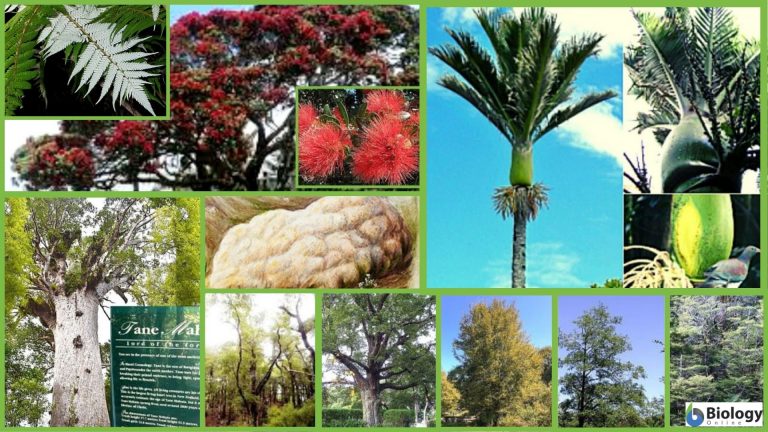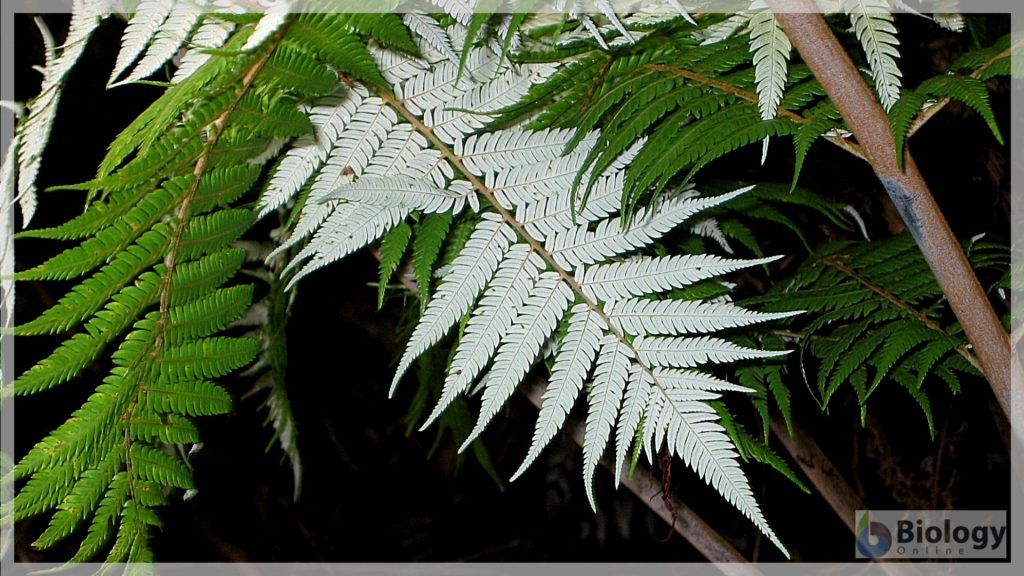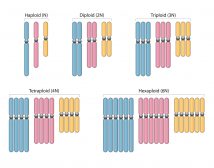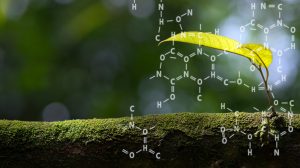New Zealand’s Unique Flora

Endemic Flora of New Zealand
Table of Contents
In the previous lesson, we’ve come to know some of the most fascinating endemic animals in New Zealand, and one of them is the takahē. In this lesson, let’s check out some of the magnificent plants found only in this country.
Similar to New Zealand’s fauna, its flora is also diverse. Around 82% of the plants are endemic, meaning they are found only here. Some of them include the world’s oldest primeval forests, the largest type of moss, and the largest tree ferns. (Ref.1)
Plants that originally from Gondwana evolved separately from their ancient relatives. Then, there are those plants that reached the country without human intervention, such as those carried by sea and wind currents. These species thrived, adapted, and reproduced. As they evolved, they also eventually acquired new features that made them unique.
Characteristics of New Zealand’s Native Flora
New Zealand’s native trees are mostly evergreen, meaning they do not shed their leaves in winter. The flowers are often small and white. Because most of the pollinators, such as moths, native bees, crawling insects, and lizards, are generally attracted by the scent, not by color, having big and colorful flowers seem unnecessary. (Ref. 1)
Many of them are dioecious, which means male and female flowers are not borne on the same tree. Thus, trees that are far from each other have to rely on wind and other agents of cross-pollination. Nonetheless, some plant species are capable of hybridism. It means a plant species can cross-pollinate with another plant species within the same family. This leads to hybrids or new plant varieties.
Apart from having wide plant varieties, some plants exhibit heteroblasty. This is when the juvenile plant looks different from the adult plant. For example, Pseudopanax crassifolius (lancewood or horoeka) produce long, thin, tough leaves when still juvenile, and when mature, they produce softer and wider leaves. (Ref.1) This feature of lancewood plants is essential to avoid excessive herbivory while they are still short and young. (Ref. 2)
Now let’s take a look at some of the interesting plants found only in New Zealand.
Silver Fern
Similar to other ferns, the tree ferns in New Zealand are flowerless and vascular plants found usually in damp, shady habitats. Both their sporophytes and gametophytes are free-living and independent of each other, which makes them different from all the other plant groups.
One of the most well-known endemic tree ferns is Alsophila dealbata, the silver fern (Māori: ponga). Because it is endemic to New Zealand, this fern became one of the country’s emblems.
The species got its name from the silver-white color on the underside of its mature fronds. Not all silver ferns have silver undersides, though. Some of them have white and others, green. (Ref. 3)
The trunk can grow up to 10m high. They prefer warm, dry habitats.

Nikau
Rhopalostylis sapida, (Māori: nīkau) is a palm tree found only in New Zealand. This plant prefers to grow in coastal to lowland forests. (Ref. 4) It can reach up to 15 m tall. It has a green stout trunk with a crownshaft that reaches up to 1 m long. The fronds are up to 3 m long with leaflets of up to 1 m long. The inflorescence consists of tightly packed flowers of lilac to pink color. The fruit is oblong and red when ripe. It is the preferred food source of the native pigeon, kererū. (Ref. 5)

Kauri
Kauri (Agathis australis) are large and strong coniferous trees. They can grow to over 50m tall and a trunk girth of up to 16m. (Ref.6) They have smooth bark and small narrow leaves. You will find the largest kauri tree in the Waipoua forest, in Northland. It is named after the Māori god of the forest, Tāne Mahuta. (Ref. 7)
The forests containing kauri trees are home to many plant species, such as taraire, kohekohe, towai, Kirk’s pine, toatoa, tanekaha, and rata. (Ref.6) Kauri serves as a foundation species. They modify the soil under their canopy, and thus, help create unique plant communities. (Ref.8)
Despite being one of the world’s strongest trees, kauri trees are facing the threat of kauri dieback, a disease caused by the fungus, Phytophthora agathidicida. The fungus attacks Kauri trees and the disease is almost always fatal to kauri. (Ref. 9) The fungus spreads through the soil. So, when visiting a kauri forest, make sure that you stay on tracks and boardwalks. Cleaning your shoes at cleaning stations helps prevent the spread of the fungus. (Ref. 9)

Pohutukawa
Pohutukawa (Metrosideros excelsa) is New Zealand’s “Christmas tree”. This is because the tree blooms around Christmas time. (Ref. 2) The species belongs to the myrtle family. The brilliant display of flowers by this tree is majestic. The tree produces vibrant red flowers (others produce orange, yellow, or white). A close inspection of the flower reveals that it is made up chiefly of a conspicuous mass of stamens. In Māori, its bloom is called kahika. (Ref.10) Pohutukawa trees are found along the coastal lines or at the cliffs around the North Island. (Ref. 7)

Southern Beech
Beech forests are Gondwana survivors. They constitute a huge part of all native New Zealand forests. (Ref. 2) They are found in the country’s mountainous lands. The five beech species of New Zealand are hard beech (Fuscospora truncata), black beech (Fuscospora solandri), red beech (Fuscospora fusca), silver beech (Lophozonia menziesii), and mountain beech (Fuscospora cliffortioides). When beech mast occurs, a dramatic rise of mice and rat population also occurs. When this happens, it could lead to “predator plague“. (Ref.11)

Beech trees form mutualism (a form of symbiosis) with a group of fungi, mycorrhizae. The fungi live on the roots of beech trees. The tree provides them with sugar while the fungi absorb soil nutrients that the tree can utilize for its growth. (Ref.11)
Beech forests also serve as a site of the honeydew ecosystem. Scale insects (Ultracoelostoma spp.) live inside the bark of the beech tree. They draw sugary sap from the tree for food. Then, they release the excess sugar via their anal tube as honeydew. This honeydew serves as food for birds, especially in winter when nectar is scarce. The honeydew that covers the bark of the tree incites the growth of sooty mold fungi, which, in turn, are a food source to a variety of insects, like beetles and moths. The small insects, then, become food for birds. (Ref. 12)
Mistletoes
Mistletoes are obligate hemiparasitic plants. Although they still photosynthesize, they must always be attached to their host plant. Otherwise, they will not survive. They attach to their host plant, for example to a tree or a shrub, via a structure called haustorium. Mistletoes use haustoria to extract water and nutrients from their host plant.
Nine mistletoe species are native to New Zealand. Three of them are found mainly in beech forest. They are red mistletoe (Peraxilla tetrapetala), scarlet mistletoe (P. colensoi), and yellow mistletoe (Alepis flavida). (Ref. 13) These species rely on beech forests for survival. (Ref.11) These mistletoes also depend on birds for pollination. While birds feed on their nectar they consequently “open” the flower, making it ready for cross-pollination. (Ref. 14)
The other five species are found in lowland forest and scrub. They are Ileostylus micranthus, Tupeia antarctica, Korthalsella salicornioides, K.lindsayi, and K. clavata. (Ref. 13)
Vegetable Sheep
In alpine areas, you can find a sheep that is capable of photosynthesis. The only thing is, it is not a real sheep but it sure looks like one! Raoulia eximia, by its scientific name, is a plant within the daisy family. It is a cushion-like plant that forms from the thousands of small plants and with woolly leaves on the outside. This plant form is believed to help conserve humidity during a harsh climate. (Ref.2)

Similar to New Zealand fauna, some of the country’s native flora are susceptible to extinction. The major threats are coming from deforestation, urban expansion, farm conversion to dairy, browsing animals, and over-collection. Thus, monitoring their population is important to become aware of their ecological status. In the next lesson, let’s learn about the methods used for data gathering and ecological research.
References:
1. The uniqueness of New Zealand plants. (2018). Science Learning Hub; Science Learning Hub. https://www.sciencelearn.org.nz/resources/2635-the-uniqueness-of-new-zealand-plants
2. Plants in New Zealand | Tourleader New Zealand – New Zealand travel guide with travelling & tourist information. (2020). Tourleader.Nz. https://www.tourleader.nz/new-zealand-travel-information/plants-new-zealand
3.Perrie, L. (2014, February). What is the silver fern? | Te Papa’s Blog. Te Papa’s Blog. https://blog.tepapa.govt.nz/2014/02/02/the-silver-fern-what-is-it/
4. Nīkau palm. (2020). Govt.Nz. https://www.doc.govt.nz/nature/native-plants/nikau-palm/
5. Wikipedia Contributors. (2020, May 5). Rhopalostylis sapida. Wikipedia; Wikimedia Foundation. https://en.wikipedia.org/wiki/Rhopalostylis_sapida
6. Kauri. (2020). Govt.Nz. https://www.doc.govt.nz/nature/native-plants/kauri/
7. Iconic New Zealand native flora. (2020). TNZ Media. https://media.newzealand.com/en/story-ideas/iconic-new-zealand-native-flora/
8. Wyse, Sarah V.; Burns, Bruce R.; Wright, Shane D. (1 June 2014). “Distinctive vegetation communities are associated with the long-lived conifer Agathis australis (New Zealand kauri, Araucariaceae) in New Zealand rainforests”. Austral Ecology. 39 (4): 388–400. doi:10.1111/aec.12089.
9. Kauri dieback. (2017). Science Learning Hub. https://www.sciencelearn.org.nz/resources/2733-kauri-dieback
10. Māori Plant Use Database Plant Use Details of Metrosideros excelsa. (2020). Landcareresearch.Co.Nz. https://maoriplantuse.landcareresearch.co.nz/WebForms/PeoplePlantsDetails.aspx?firstcome=firstcome&PKey=9F92ED8B-2C9F-4BB2-85FE-60203014CD23
11. Beech forest. (2014). Govt.Nz. https://www.doc.govt.nz/nature/native-plants/beech-forest/
12. Honeydew ecosystem. (2020). Science Learning Hub. https://www.sciencelearn.org.nz/resources/1436-honeydew-ecosystem
13. Mistletoe. (2020). Govt.Nz. https://www.doc.govt.nz/nature/native-plants/mistletoe/
14. Mistletoes and mutualism. (2012). Science Learning Hub. https://www.sciencelearn.org.nz/resources/74-mistletoes-and-mutualism
You will also like...

Arthropods
The arthropods were assumed to be the first taxon of species to possess jointed limbs and exoskeleton, exhibit more adva..

Polyploidy
Humans are diploid creatures. This means that for every chromosome in the body, there is another one to match it. Howeve..

A Balanced Diet – Minerals and Proteins
Proteins and minerals can be derived from various dietary sources. They are essential for the proper growth and developm..

Examples of Natural Selection
Darwin's Finches are an example of natural selection in action. They are an excellent example of the way species' gene p..

IQ, Creativity and Learning
Human intelligence provided the means to utilize abstract ideas and implement reasoning. This tutorial takes a further l..

Effect of Chemicals on Growth & Development in Organisms
Plants and animals need elements, such as nitrogen, phosphorus, potassium, and magnesium for proper growth and developme..
